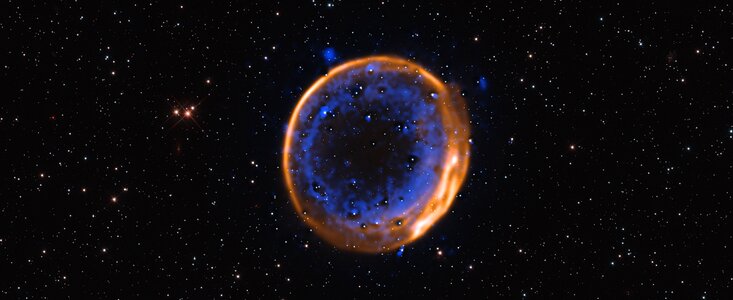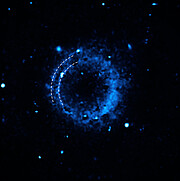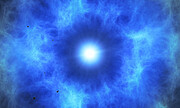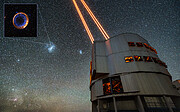Comunicato Stampa
Doppia detonazione: una nuova immagine mostra i resti una stella distrutti da due esplosioni
02 Luglio 2025

Per la prima volta, alcuni astronomi hanno ottenuto la prova visiva di una stella che ha incontrato la propria fine con una doppia esplosione. Studiando i resti secolari della supernova SNR 0509-67.5 con il VLT (Very Large Telescope) dell'ESO (Osservatorio Europeo Australe), hanno trovato strutture che confermano come la stella abbia subito un paio di forti esplosioni. Pubblicata oggi, questa scoperta mostra sotto una nuova luce alcune delle esplosioni più importanti dell'Universo.
La maggior parte delle supernovae risulta dalla morte esplosiva di stelle massicce, ma una varietà importante ha origine da oggetti poco appariscenti. Le nane bianche, quei piccoli nuclei stellari inattivi rimasti dopo che stelle come il Sole hanno esaurito il combustibile nucleare, possono produrre quella che gli astronomi chiamano supernova di tipo Ia.
"Le esplosioni delle nane bianche svolgono un ruolo cruciale in astronomia", afferma Priyam Das, dottorando presso l'Università del Nuovo Galles del Sud a Canberra, in Australia, a capo dello studio su SNR 0509-67.5 pubblicato oggi su Nature Astronomy. Gran parte della nostra conoscenza sull'espansione dell'Universo si basa sulle supernove di tipo Ia, che rappresentano anche la principale fonte di ferro sul nostro pianeta, compreso il ferro presente nel nostro sangue. "Eppure, nonostante la loro importanza, l'annoso enigma dell'esatto meccanismo che ne innesca l'esplosione rimane irrisolto", aggiunge.
Tutti i modelli che spiegano le supernovae di tipo Ia partono da una nana bianca in una coppia di stelle. Se le stelle in orbita sono abbastanza vicine, la nana bianca può rubare materiale alla compagna. Nella teoria più consolidata che speiga le supernovae di tipo Ia, la nana bianca accumula materia dalla compagna fino a raggiungere una massa critica, punto in cui si verifica una singola esplosione. Tuttavia, studi recenti hanno suggerito che almeno alcune supernove di tipo Ia potrebbero essere spiegate meglio da una doppia esplosione innescata prima che la stella abbia raggiunto questa massa critica.
Ora, alcuni astronomi hanno catturato una nuova immagine che dimostra che l'intuizione fosse corretta: almeno alcune supernove di tipo Ia esplodono attraverso un meccanismo di "doppia detonazione". In questo modello alternativo, la nana bianca forma attorno a sé una coltre di elio, rubato alla compagna, che può diventare instabile e incendiarsi. Questa prima esplosione genera un'onda d'urto che si muove intorno alla nana bianca e verso l'interno, innescando una seconda detonazione nel nucleo della stella, che infine crea la supernova.
Finora, non c'erano prove chiare e visive di una nana bianca con una doppia detonazione. Recentemente, alcuni astronomi hanno previsto che questo processo avrebbe creato un disegno distintivo, o un'impronta digitale, nei resti ancora luminosi della supernova, visibile molto tempo dopo l'esplosione iniziale. La ricerca suggerisce che i resti di una tale supernova dovrebbero contenere due diversi gusci di calcio.
E ora hanno trovato questa impronta digitale nei resti di una supernova. Ivo Seitenzahl, che ha guidato le osservazioni e lavorava presso l'Istituto tedesco di Studi Teorici di Heidelberg al momento dello studio, afferma che questi risultati mostrano "una chiara indicazione che le nane bianche possono esplodere ben prima di raggiungere il famoso limite di massa di Chandrasekhar e che il meccanismo della 'doppia detonazione' si verifica effettivamente in natura". L'equipe ha identificato gli strati di calcio (in blu nell'immagine) nel resto di supernova SNR 0509-67.5 osservandolo con lo strumento MUSE (Multi Unit Spectroscopic Explorer) installato sul VLT dell'ESO. Ciò fornisce una solida prova che una supernova di tipo Ia può verificarsi prima che la nana bianca raggiunga la massa critica.
Type Ia supernovae are key to our understanding of the Universe. They behave in very consistent ways, and their predictable brightness — no matter how far away they are — helps astronomers to measure distances in space. Using them as a cosmic measuring tape, astronomers discovered the accelerating expansion of the Universe, a discovery that won the Physics Nobel Prize in 2011. Studying how they explode helps us to understand why they have such a predictable brightness.
Das cita un'altra motivazione per studiare queste esplosioni. "Questa prova tangibile di una doppia detonazione non solo contribuisce a risolvere un mistero di lunga data, ma offre anche uno spettacolo visivo", afferma, descrivendo la "struttura splendidamente stratificata" che una supernova può creare. Per lui, "svelare il meccanismo che produce un'esplosione cosmica così spettacolare è incredibilmente gratificante".
Ulteriori Informazioni
Il risultato di questo lavoro è descritto in un articolo pubblicato da Nature Astronomy intitolato “Calcium in a supernova remnant shows the fingerprint of a sub-Chandrasekhar mass explosion”.
L'equipe è formata da P. Das (University of New South Wales, Australia [UNSW] & Heidelberger Institut für Theoretische Studien, Heidelberg, Germania [HITS]), I. R. Seitenzahl (HITS), A. J. Ruiter (UNSW & HITS & OzGrav: The ARC Centre of Excellence for Gravitational Wave Discovery, Hawthorn, Australia & ARC Centre of Excellence for All-Sky Astrophysics in 3 Dimensions), F. K. Röpke (HITS & Institut für Theoretische Astrophysik, Heidelberg, Germania & Astronomisches Recheninstitut, Heidelberg, Germania), R. Pakmor (Max-Planck-Institut für Astrophysik, Garching, Germania [MPA]), F. P. A. Vogt (Federal Office of Meteorology and Climatology – MeteoSwiss, Payerne, Switzerland), C. E. Collins (The University of Dublin, Dublin, Irlanda & GSI Helmholtzzentrum für Schwerionenforschung, Darmstadt, Germania), P. Ghavamian (Towson University, Towson, USA), S. A. Sim (Queen’s University Belfast, Belfast, Regno Unito), B. J. Williams (X-ray Astrophysics Laboratory NASA/GSFC, Greenbelt, USA), S. Taubenberger (MPA & Technical University Munich, Garching, Germania), J. M. Laming (Naval Research Laboratory, Washington, USA), J. Suherli (University of Manitoba, Winnipeg, Canada), R. Sutherland (Australian National University, Weston Creek, Australia), e N. Rodríguez-Segovia (UNSW).
L'ESO (European Southern Observatory o Osservatorio Europeo Australe) consente agli scienziati di tutto il mondo di scoprire i segreti dell'Universo a beneficio di tutti. Progettiamo, costruiamo e gestiamo da terra osservatori di livello mondiale - che gli astronomi utilizzano per affrontare temi interessanti e diffondere il fascino dell'astronomia - e promuoviamo la collaborazione internazionale per l'astronomia. Fondato come organizzazione intergovernativa nel 1962, oggi l'ESO è sostenuto da 16 Stati membri (Austria, Belgio, Danimarca, Francia, Finlandia, Germania, Irlanda, Italia, Paesi Bassi, Polonia, Portogallo, Regno Unito, Repubblica Ceca, Spagna, Svezia e Svizzera), insime con il paese che ospita l'ESO, il Cile, e l'Australia come partner strategico. Il quartier generale dell'ESO e il Planetario e Centro Visite Supernova dell'ESO si trovano vicino a Monaco, in Germania, mentre il deserto cileno di Atacama, un luogo meraviglioso con condizioni uniche per osservare il cielo, ospita i nostri telescopi. L'ESO gestisce tre siti osservativi: La Silla, Paranal e Chajnantor. Sul Paranal, l’ESO gestisce il VLT (Very Large Telescope) e il VLTI (Very Large Telescope Interferometer), così come due telescopi per survey, VISTA, che lavora nell'infrarosso, e VST (VLT Survey Telescope) in luce visibile. Sempre a Paranal l'ESO ospiterà e gestirà la schiera meridionale di telescopi di CTA, il Cherenkov Telescope Array Sud, il più grande e sensibile osservatorio di raggi gamma del mondo. Insieme con partner internazionali, l’ESO gestisce APEX e ALMA a Chajnantor, due strutture che osservano il cielo nella banda millimetrica e submillimetrica. A Cerro Armazones, vicino a Paranal, stiamo costruendo "il più grande occhio del mondo rivolto al cielo" - l'ELT (Extremely Large Telescope, che significa Telescopio Estremamente Grande) dell'ESO. Dai nostri uffici di Santiago, in Cile, sosteniamo le operazioni nel paese e collaboriamo con i nostri partner e la società cileni.
La traduzione dall'inglese dei comunicati stampa dell'ESO è un servizio dalla Rete di Divulgazione Scientifica dell'ESO (ESON: ESO Science Outreach Network) composta da ricercatori e divulgatori scientifici da tutti gli Stati Membri dell'ESO e altri paesi. Il nodo italiano della rete ESON è gestito da Anna Wolter.
Links
- Articolo scientifico
- Immagini del VLT
- Per i giornalisti: iscrivetevi per ricevere i nostri comunicati sotto embargo nella vostra lingua e fate domanda per un visita strategica all'ESO (con parziale supporto finanziario) nel 2025 (Novità)
- Per i ricercatori: avete una storia da raccontare? Promuovete il vostro articolo scientifico
- Una nuova analisi dell'ESO conferma che gravi danni sarebbero causati dal complesso industriale pianificato vicino al Paranal
Contatti
Priyam Das
School of Science (Astrophysics), University of New South Wales at the Australian Defence Force Academy
Canberra, Australia
E-mail: priyam.das@unsw.edu.au
Ashley Ruiter
School of Science (Astrophysics), University of New South Wales at the Australian Defence Force Academy
Canberra, Australia
E-mail: ashley.ruiter@unsw.edu.au
Ivo Seitenzahl
Heidelberg Institute for Theoretical Studies
Heidelberg, Germany (currently in Canberra, Australia)
E-mail: ivoseitenzahl@gmail.com
Friedrich Röpke
Heidelberg Institute for Theoretical Studies
Heidelberg, Germany
E-mail: friedrich.roepke@h-its.org
Bárbara Ferreira
ESO Media Manager
Garching bei München, Germany
Tel.: +49 89 3200 6670
Cell.: +49 151 241 664 00
E-mail: press@eso.org
Anna Wolter (press contact Italia)
Rete di divulgazione scientifica dell'ESO
e INAF-Osservatorio Astronomico di Brera
Milano, Italy
Tel.: +39 02 72320321
E-mail: eson-italy@eso.org
Sul Comunicato Stampa
| Comunicato Stampa N": | eso2511it |
| Nome: | SNR 0509-67.5 |
| Tipo: | Milky Way : Nebula : Type : Supernova Remnant |
| Facility: | Very Large Telescope |
| Instruments: | MUSE |
Our use of Cookies
We use cookies that are essential for accessing our websites and using our services. We also use cookies to analyse, measure and improve our websites’ performance, to enable content sharing via social media and to display media content hosted on third-party platforms.
ESO Cookies Policy
The European Organisation for Astronomical Research in the Southern Hemisphere (ESO) is the pre-eminent intergovernmental science and technology organisation in astronomy. It carries out an ambitious programme focused on the design, construction and operation of powerful ground-based observing facilities for astronomy.
This Cookies Policy is intended to provide clarity by outlining the cookies used on the ESO public websites, their functions, the options you have for controlling them, and the ways you can contact us for additional details.
What are cookies?
Cookies are small pieces of data stored on your device by websites you visit. They serve various purposes, such as remembering login credentials and preferences and enhance your browsing experience.
Categories of cookies we use
Essential cookies (always active): These cookies are strictly necessary for the proper functioning of our website. Without these cookies, the website cannot operate correctly, and certain services, such as logging in or accessing secure areas, may not be available; because they are essential for the website’s operation, they cannot be disabled.
Functional Cookies: These cookies enhance your browsing experience by enabling additional features and personalization, such as remembering your preferences and settings. While not strictly necessary for the website to function, they improve usability and convenience; these cookies are only placed if you provide your consent.
Analytics cookies: These cookies collect information about how visitors interact with our website, such as which pages are visited most often and how users navigate the site. This data helps us improve website performance, optimize content, and enhance the user experience; these cookies are only placed if you provide your consent. We use the following analytics cookies.
Matomo Cookies:
This website uses Matomo (formerly Piwik), an open source software which enables the statistical analysis of website visits. Matomo uses cookies (text files) which are saved on your computer and which allow us to analyze how you use our website. The website user information generated by the cookies will only be saved on the servers of our IT Department. We use this information to analyze www.eso.org visits and to prepare reports on website activities. These data will not be disclosed to third parties.
On behalf of ESO, Matomo will use this information for the purpose of evaluating your use of the website, compiling reports on website activity and providing other services relating to website activity and internet usage.
Matomo cookies settings:
Additional Third-party cookies on ESO websites: some of our pages display content from external providers, e.g. YouTube.
Such third-party services are outside of ESO control and may, at any time, change their terms of service, use of cookies, etc.
YouTube: Some videos on the ESO website are embedded from ESO’s official YouTube channel. We have enabled YouTube’s privacy-enhanced mode, meaning that no cookies are set unless the user actively clicks on the video to play it. Additionally, in this mode, YouTube does not store any personally identifiable cookie data for embedded video playbacks. For more details, please refer to YouTube’s embedding videos information page.
Cookies can also be classified based on the following elements.
Regarding the domain, there are:
- First-party cookies, set by the website you are currently visiting. They are stored by the same domain that you are browsing and are used to enhance your experience on that site;
- Third-party cookies, set by a domain other than the one you are currently visiting.
As for their duration, cookies can be:
- Browser-session cookies, which are deleted when the user closes the browser;
- Stored cookies, which stay on the user's device for a predetermined period of time.
How to manage cookies
Cookie settings: You can modify your cookie choices for the ESO webpages at any time by clicking on the link Cookie settings at the bottom of any page.
In your browser: If you wish to delete cookies or instruct your browser to delete or block cookies by default, please visit the help pages of your browser:
Please be aware that if you delete or decline cookies, certain functionalities of our website may be not be available and your browsing experience may be affected.
You can set most browsers to prevent any cookies being placed on your device, but you may then have to manually adjust some preferences every time you visit a site/page. And some services and functionalities may not work properly at all (e.g. profile logging-in, shop check out).
Updates to the ESO Cookies Policy
The ESO Cookies Policy may be subject to future updates, which will be made available on this page.
Additional information
For any queries related to cookies, please contact: pdprATesoDOTorg.
As ESO public webpages are managed by our Department of Communication, your questions will be dealt with the support of the said Department.







